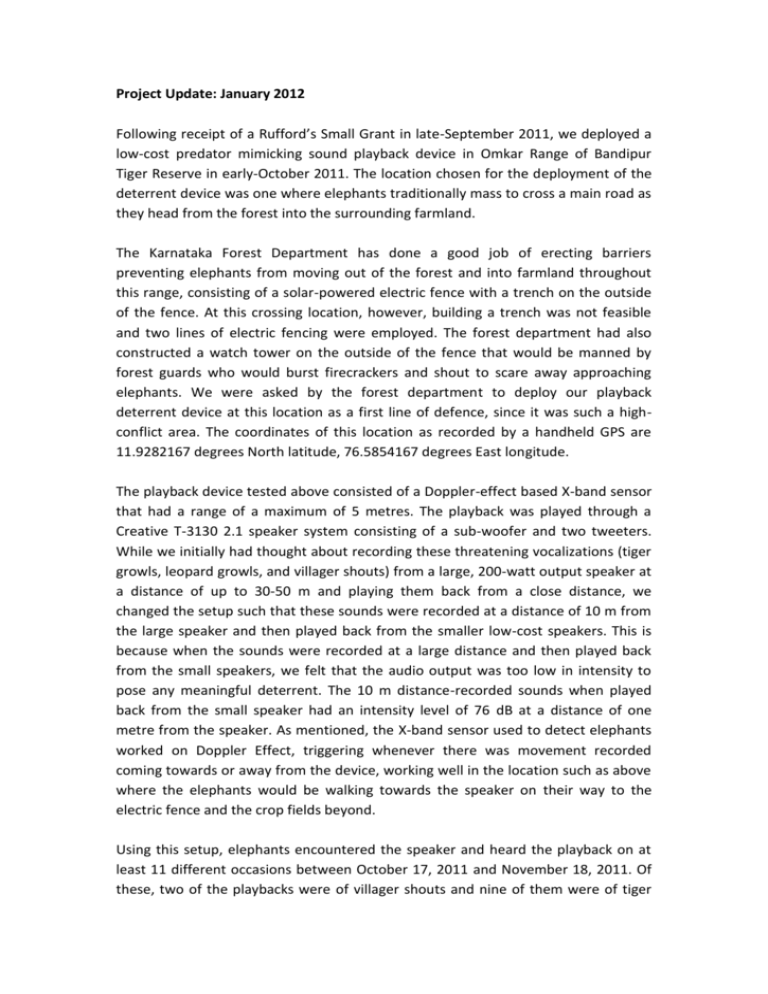Experimental Mitigation of Crop-Raiding by Asian Elephants
advertisement

Project Update: January 2012 Following receipt of a Rufford’s Small Grant in late-September 2011, we deployed a low-cost predator mimicking sound playback device in Omkar Range of Bandipur Tiger Reserve in early-October 2011. The location chosen for the deployment of the deterrent device was one where elephants traditionally mass to cross a main road as they head from the forest into the surrounding farmland. The Karnataka Forest Department has done a good job of erecting barriers preventing elephants from moving out of the forest and into farmland throughout this range, consisting of a solar-powered electric fence with a trench on the outside of the fence. At this crossing location, however, building a trench was not feasible and two lines of electric fencing were employed. The forest department had also constructed a watch tower on the outside of the fence that would be manned by forest guards who would burst firecrackers and shout to scare away approaching elephants. We were asked by the forest department to deploy our playback deterrent device at this location as a first line of defence, since it was such a highconflict area. The coordinates of this location as recorded by a handheld GPS are 11.9282167 degrees North latitude, 76.5854167 degrees East longitude. The playback device tested above consisted of a Doppler-effect based X-band sensor that had a range of a maximum of 5 metres. The playback was played through a Creative T-3130 2.1 speaker system consisting of a sub-woofer and two tweeters. While we initially had thought about recording these threatening vocalizations (tiger growls, leopard growls, and villager shouts) from a large, 200-watt output speaker at a distance of up to 30-50 m and playing them back from a close distance, we changed the setup such that these sounds were recorded at a distance of 10 m from the large speaker and then played back from the smaller low-cost speakers. This is because when the sounds were recorded at a large distance and then played back from the small speakers, we felt that the audio output was too low in intensity to pose any meaningful deterrent. The 10 m distance-recorded sounds when played back from the small speaker had an intensity level of 76 dB at a distance of one metre from the speaker. As mentioned, the X-band sensor used to detect elephants worked on Doppler Effect, triggering whenever there was movement recorded coming towards or away from the device, working well in the location such as above where the elephants would be walking towards the speaker on their way to the electric fence and the crop fields beyond. Using this setup, elephants encountered the speaker and heard the playback on at least 11 different occasions between October 17, 2011 and November 18, 2011. Of these, two of the playbacks were of villager shouts and nine of them were of tiger growls. Of these, on eight occasions (two villager shout and five tiger growl playback events), the playbacks deterred elephants from approaching the fence while on the remaining three occasions, the tiger growls did not deter elephants from progressing further and the forest guards had to get involved to drive the elephants away. On at least a further four occasions, the elephants were able to bypass the playback device without triggering a sound playback. The design of the playback device was drastically altered in November 2011. One of the changes incorporated was the removal of the X-band detector as the sensor and its replacement with a passive-infrared based sensor. One reason for this was that the X-band Doppler Effect based sensor was highly prone to false trips, particularly in the immediate aftermaths of rain events. After a rain event, the X-band sensor would repeatedly trigger playbacks from the speaker for multiple hours, completely draining the battery. While this problem was mitigated to a certain extent by reducing the sensitivity of the sensor, this also shortened its detection range from 5 m to roughly 2 to 3 m at most. We deemed this to be far too short to effectively control elephants over the long run and also felt that there was a danger to the playback system itself from damage by elephants if the playback was triggered at such a close distance, therefore we changed the sensor ahead of the peak cropraiding season began in late-November. The change of the sensor also brought with it a change in the way the system was operated. Previously, the system had been on continuously and would trigger a playback when the sensor sent a signal. This was changed so that the trigger was constantly on but the entire system remained powered off until the sensor detected something at which point the system would be powered on and the playback would take place. This increased battery life tremendously from less than a day previously to more than 1 month. Another playback device was placed at one other location within Omkar Range of Bandipur Tiger Reserve a few hundred metres from the first location. This location was where the trench on the outside of the fence was not present because there was a road leading into the forest from the main road outside here. There was a detachable electric fence across the road, but the elephants still targeted this area because of the comparative ease of crossing here. This location too had a forest department watchtower where guards were placed and we were asked by the forest department to reinforce this location with our playback device. The coordinates of the speaker at this location are 11.9285333 degrees North latitude and 76.5905833 degrees East longitude. This new location was referred to as Omkar East and the original location would be referred to as Omkar West. The speaker at Omkar West was also upgraded from the Creative T3130 speaker to the large 200-watt amplifier used previously. This was necessitated by the change of the operating method of the system, from constantly on to being powered on by the sensor when a playback was needed. Because the system was being powered on each time, the mp3 player had a roughly 6 second lag between when it was turned on to when it would playback the sound through the speaker. In this time, the small Creative T3130 speakers had a background static buzz that was audible to the elephants. The larger speakers did not have this static buzz when turned on and prior to the playback taking place, so we decided to test them along with the smaller speakers. So while the Omkar West system was upgraded to include a large speaker, the small speakers were continued to be used at the Omkar East location. The vocalizations played back from the large speakers were 97 dB in intensity at a distance of 1 m from the source and 77 dB at a distance of 10 m. We also set up two of these playback devices with the PIR-sensor in Wayanad District of the neighbouring state of Kerala. Two playback devices, one with a large speaker and one with a small speaker, were set up in the village of Kottangere. The large speaker location was noted as Kottangere North and the small speaker location was noted as Kottangere South. Using this setup, elephants encountered the playback devices on at least 33 different occasions between November 23, 2011 and December 14, 2011. Of these, three of the playbacks were of tiger growls from the large speaker, five were of the villager shouts from the large speaker, and 25 of them were of tiger growls from the small speakers. Of these, on at least two occasions the playbacks were not effective in scaring away elephants from the area and these were in the case of tiger growls being played back from the small speaker. On at least a further 13 occasions, the elephants were able to bypass the playback device without triggering a sound playback, although six of these occasions were after an event where an elephant kicked the box containing the large speaker at Omkar West after a villager shout playback with the result of the system being temporarily damaged and de-activated from December 6, 2011 to December 8, 2011. In mid-December 2011, the playback system at Omkar East was upgraded from a small speaker to a large speaker. This was because the forest guards said that the larger speaker produced a louder sound and served as a warning signal for them that elephants were nearby, while the smaller speaker’s sound often wasn’t audible for them at a distance of nearly 75 m from the device and away from the direction that the playback device was pointed at. The playback system at Omkar West too was upgraded by adding a second sensor to it. The second sensor was used to cover a path to the left of the speaker that had been previously not addressed because it was rarely used by elephants. By using two sensors for the playback system at Omkar West, we were able to provide the device with a larger field of view. At the same time, we also moved both playback devices from the village of Kottangere in Wayanad district to the village of Manimunda, also in Wayanad District of Kerala. The reason for this was that Kottangere had numerous points at which elephants could enter the village. Since we only had two playback devices to spare, we could not cut off all access points to the village and elephants deterred from the access point where we had placed our speaker would simply choose another location through which to enter the village. At the village of Manimunda, the electric fencing and trenching around the village were complete enough that there were only two small paths through which elephants could enter the village, providing a perfect setup for our study. Also, while in Kottangere, there were no crops left after the end of the December harvest season, Manimunda still had banana and coconut groves that would be attractive to elephants and would likely continue to be raided even after the main crop-raiding season ended in December. The path leading into the forest to the north of the village was first blocked by the playback system. This location was referred to as Manimunda North and the coordinates for the speaker at this location are 11.6925833 degrees North latitude and 76.3102 degrees East longitude. Another playback system was placed at the other entrance to this village roughly 200 m south of this location and was referred to Manimunda South. Both these systems were equipped with the larger 200-watt speakers, thus all four playback systems in use from mid-December onwards contained the large speakers. We also started testing playbacks of African lion growls (based on the MGM opening theme) to see how elephants would react to the sound of an unfamiliar animal, since lions and Asian elephants haven’t co-existed since the last ice-age. Using this setup, elephants encountered the playback devices on at least 21 different occasions between December 16, 2011 and February 15, 2012. Of these, 16 of the playbacks were of lion growls and five playbacks were of a tiger growl. Of these, on at least two occasions the playbacks were not effective in scaring away elephants from the area and these were in the case of lion growls being played back. On at least a further five occasions, the elephants were able to bypass the playback device without triggering a sound playback. With the crop-raiding season mainly over, most of the work in February 2012 has been regarding the development of components of this playback system indigenously. To this end, we have approached bachelor’s degree students in engineering from two colleges, one in Bangalore and one in Mysore, to develop a low-cost, basic system of PIR sensor plus sound playback board that would be connected to the speaker. Over the coming weeks, we will be training forest department personnel on basic maintenance of these playback devices since they will be left in their current locations post completion of this project. Over the coming months, we will be performing detailed analyses of the videos to catalogue detailed elephant behaviours in response to the sound playbacks and determine which categories of sounds work best and under what combinations of other deterrents we had seen maximum deterrence of elephants. This information will be contained in the Final Project Report that will be delivered to Rufford Small Grants Foundation.







